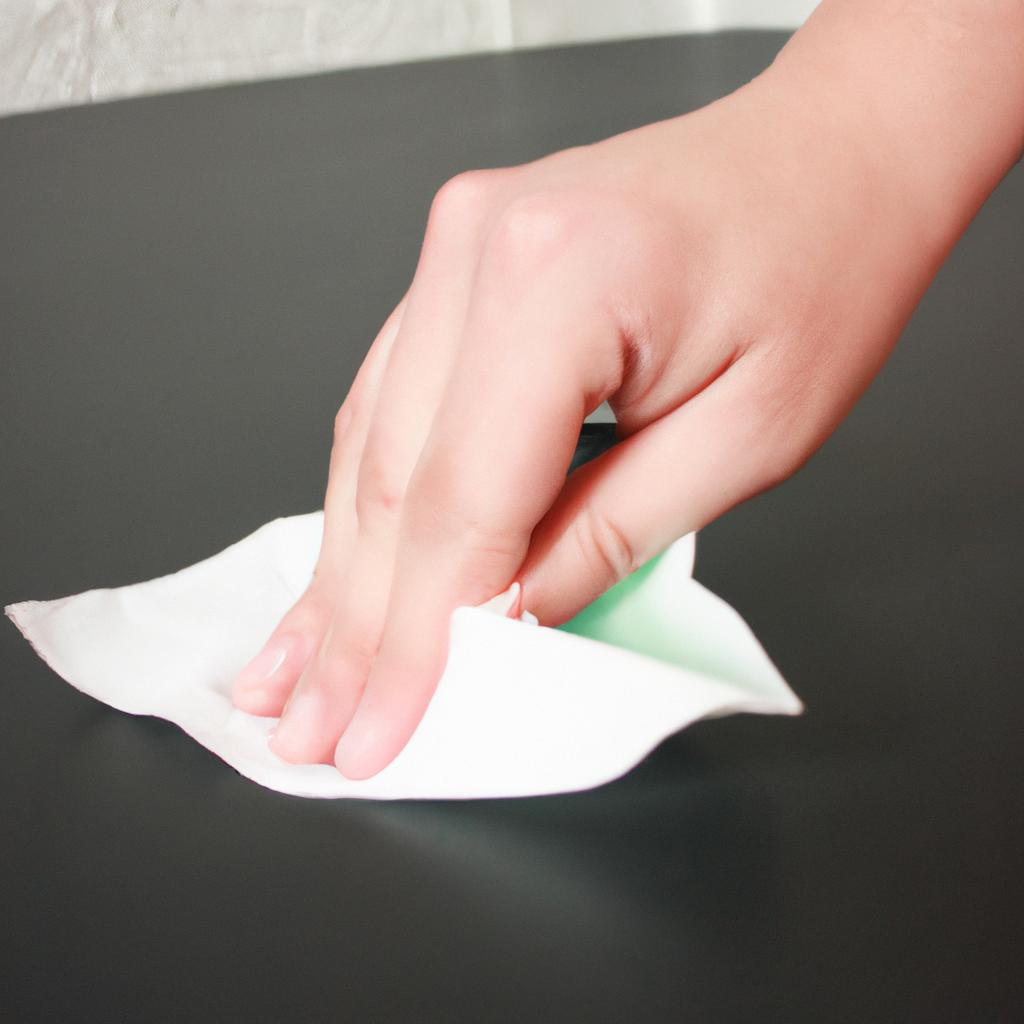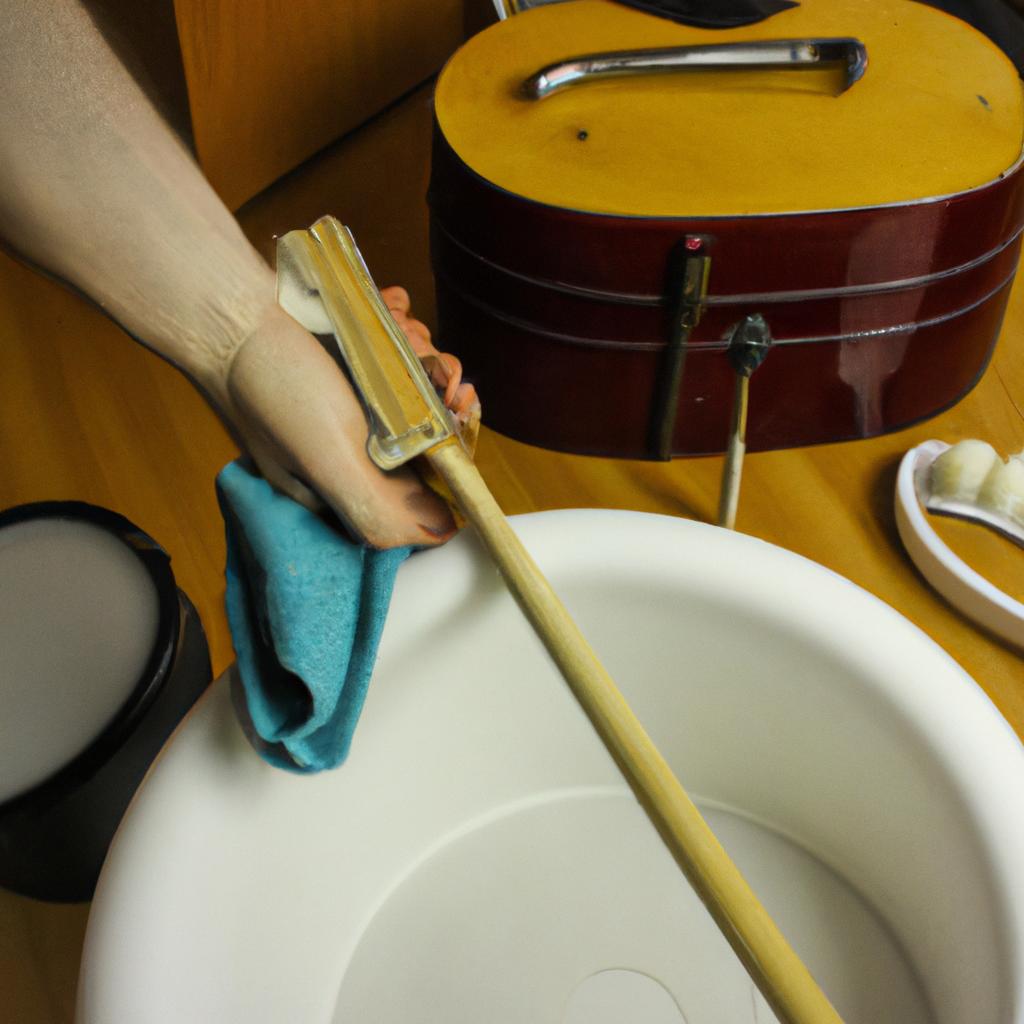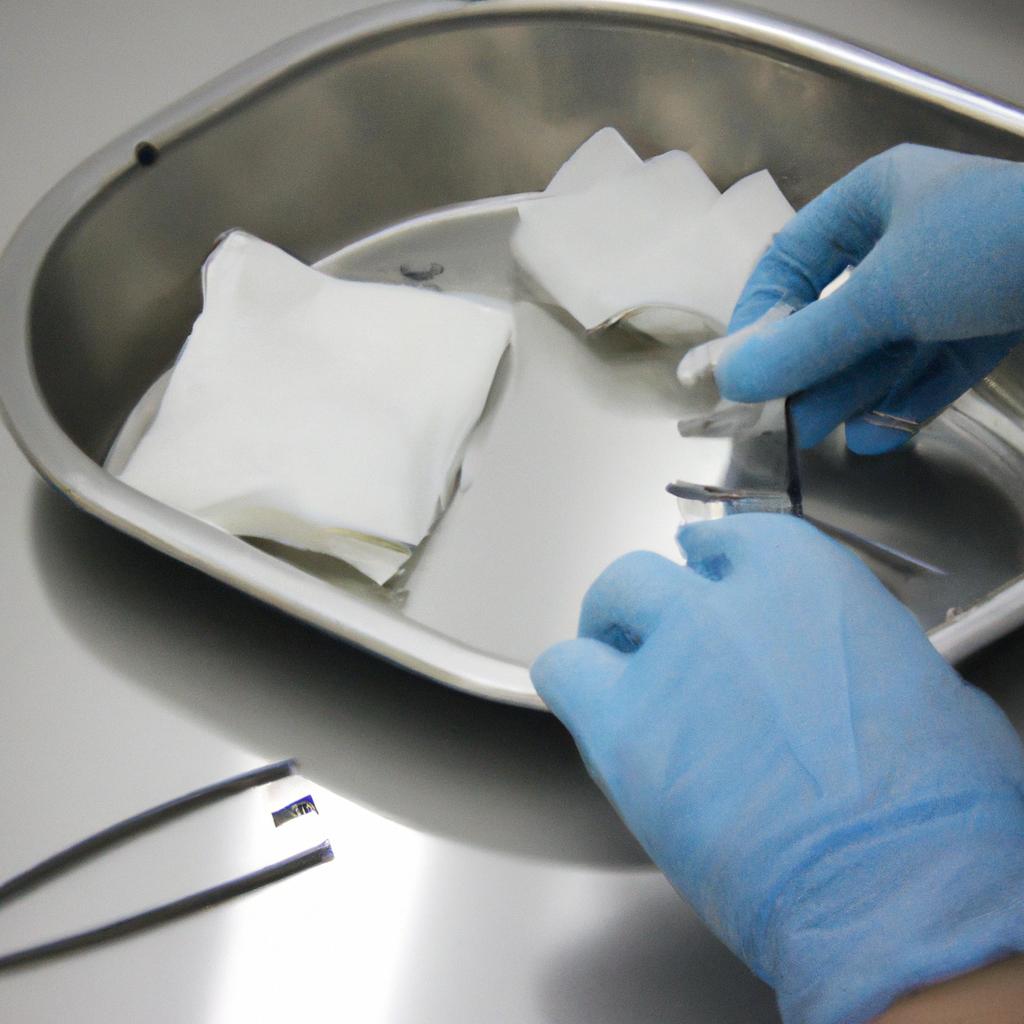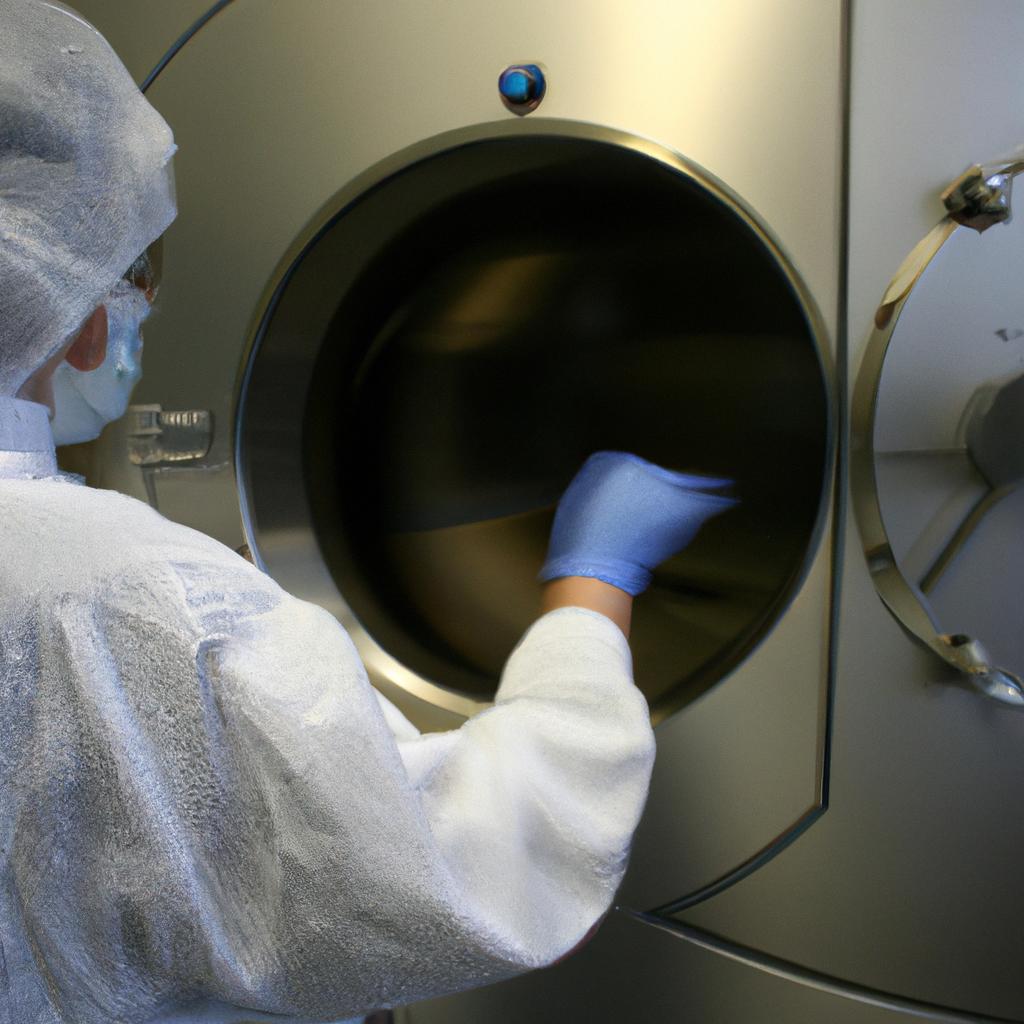The importance of proper cleaning and sterilization of instruments and supplies cannot be overstated in various industries, including healthcare, food service, and laboratory settings. Disinfectant wipes have emerged as an essential tool for achieving effective cleaning and sterilization outcomes due to their convenience and effectiveness. For instance, consider a hypothetical scenario where a hospital is faced with the challenge of controlling a potential outbreak of infectious diseases among its patients. In such cases, disinfectant wipes can play a crucial role in preventing cross-contamination by ensuring thorough cleaning and sterilization.
In this article, we will explore the use of disinfectant wipes as a vital component in the process of cleaning and sterilizing instruments and supplies. First, we will delve into the different types of disinfectant wipes available on the market today, highlighting their specific features and advantages. Next, we will discuss the key factors to consider when selecting the appropriate disinfectant wipe for a particular application. This will include examining factors such as efficacy against pathogens, compatibility with different surfaces and materials, ease of use, and environmental considerations. Finally, we will provide practical guidelines for using disinfectant wipes effectively to maximize their benefits while minimizing any potential risks or drawbacks associated with their usage.
Note: The introduction contains …containing an overview of the article’s contents and an explanation of why proper cleaning and sterilization are crucial in various industries.
Understanding Disinfectant Wipes
Imagine a scenario where medical professionals are in the midst of performing a critical surgical procedure. As they reach for their supplies, they encounter an unexpected obstacle—a contaminated instrument. This situation highlights the crucial role that disinfectant wipes play in maintaining cleanliness and preventing the spread of harmful pathogens. In this section, we will delve into the key aspects of understanding disinfectant wipes, exploring their composition, effectiveness, and proper usage.
To begin with, let us consider what makes disinfectant wipes so effective in combating germs and bacteria. These wipes typically consist of a combination of chemicals such as quaternary ammonium compounds (quats), isopropyl alcohol, hydrogen peroxide, or sodium hypochlorite. The specific formulation may vary depending on the desired level of disinfection. For instance, some wipes are designed for general surface cleaning purposes while others possess stronger antimicrobial properties suitable for healthcare settings.
When it comes to assessing the efficacy of disinfectant wipes, several factors come into play. Firstly, it is essential to understand that not all wipes are created equal; different products have varying levels of effectiveness against specific microorganisms. Secondly, contact time—the duration during which the wipe remains in contact with the surface—plays a vital role in achieving optimal results. Additionally, certain surfaces may require pre-cleaning before applying disinfectant wipes to ensure maximum efficiency.
Now let us explore how using disinfectant wipes can evoke a sense of security and confidence among users:
- Convenience: With their ready-to-use nature and no requirement for additional mixing or dilution processes like liquid cleaners, disinfectant wipes offer convenience and ease-of-use.
- Portability: Compact packaging allows for easy transportation and accessibility in various environments.
- Efficiency: By eliminating the need for multiple cleaning steps involving separate products or equipment, these wipes save valuable time.
- Peace of Mind: Knowing that each wipe is pre-saturated with a specific solution formulated for effective disinfection instills confidence in the user.
To summarize, understanding the composition and effectiveness of disinfectant wipes is crucial in maintaining cleanliness and preventing the spread of harmful pathogens. By considering factors such as formulation, contact time, and pre-cleaning requirements, users can ensure optimal results. The convenience, portability, efficiency, and peace of mind provided by these wipes further enhance their appeal. In the subsequent section on “Choosing the Right Disinfectant Wipes,” we will explore key considerations to keep in mind while selecting an appropriate product for your specific needs.
Choosing the Right Disinfectant Wipes
Understanding Disinfectant Wipes: A Case Study
Imagine a scenario where a dental clinic is preparing for an influx of patients. With the ongoing concern over infection control, it becomes crucial to ensure that all instruments and supplies are properly cleaned and sterilized. One effective method in this regard is the use of disinfectant wipes. These wipes offer convenience and ease of use while effectively eliminating harmful microorganisms from surfaces.
To fully comprehend the benefits and limitations of disinfectant wipes, it is essential to understand their composition and mechanism of action. Disinfectant wipes typically contain active ingredients such as alcohol or quaternary ammonium compounds (quats). These chemicals work by disrupting the cell membranes or proteins of microorganisms, rendering them incapable of reproducing or causing harm. The concentration and contact time required may vary depending on the specific product, so it is important to follow manufacturer recommendations diligently.
When choosing the right disinfectant wipes for your needs, consider the following factors:
- Spectrum of activity: Ensure that the wipes you select are capable of eliminating a broad range of pathogens commonly found in your practice setting.
- Compatibility: Verify that the wipes are safe to use on different types of surfaces and materials without causing damage or discoloration.
- Ease of use: Opt for wipes that come in convenient packaging with clear instructions for proper usage, minimizing any potential errors.
- Environmental impact: Look for products that have minimal adverse effects on the environment during production, usage, and disposal.
By considering these aspects, you can make informed decisions when selecting disinfectant wipes that align with your specific requirements.
In addition to understanding how disinfectant wipes function and how to choose suitable ones, it is crucial to become familiar with their practical application within healthcare settings. The table below outlines some key considerations:
| Considerations | Example | Importance |
|---|---|---|
| Proper technique | Wiping surfaces in a back-and-forth motion | Ensures even distribution of disinfectant |
| Contact time | Allowing the surface to remain wet for 2 minutes | Sufficient time for effective disinfection |
| Frequency of use | Using wipes after each patient encounter | Minimizes cross-contamination risks |
| Storage and expiration | Storing wipes in a cool, dry place | Maintains effectiveness within shelf life |
By adhering to these guidelines, you can optimize the efficacy of disinfectant wipes and mitigate potential risks associated with inadequate cleaning and sterilization practices.
In preparation for the subsequent section on the proper usage and application of disinfectant wipes, it is crucial to establish a solid understanding of their composition, selection criteria, and practical considerations. By integrating this knowledge into your infection control protocols, you can ensure a safe and hygienic environment that instills confidence in both patients and healthcare professionals alike.
Proper Usage and Application of Disinfectant Wipes
Section H2: Proper Usage and Application of Disinfectant Wipes
Imagine this scenario: A busy hospital room with medical professionals working diligently to provide care for patients. In the midst of their tasks, they reach for a container of disinfectant wipes to clean and sterilize their instruments and supplies. But do they know how to properly use these wipes? In this section, we will explore the essential guidelines for the proper usage and application of disinfectant wipes.
To begin, let’s outline four key steps that should be followed when using disinfectant wipes:
- Pre-cleaning: Before using the wipe, it is crucial to pre-clean the surface or instrument being disinfected. This step removes any visible dirt or debris, allowing the disinfectant solution on the wipe to effectively target harmful microorganisms.
- Contact time: Each disinfectant wipe has specific instructions regarding contact time – the duration required for the active ingredients in the wipe to eliminate pathogens. It is important not to rush this step; adhering to the recommended contact time ensures thorough disinfection.
- Coverage area: When using a disinfectant wipe, ensure that you cover all areas of the surface or object being cleaned. Pay particular attention to commonly touched areas such as handles, buttons, and switches.
- Proper disposal: After use, dispose of used wipes according to facility protocols and regulations. This prevents cross-contamination and maintains a hygienic environment.
Now let’s delve into a case study highlighting why following proper usage guidelines is critical:
| Case Study |
|---|
| Hospital X recently experienced an outbreak of healthcare-associated infections (HAIs) in one of its surgical units. Upon investigation, it was discovered that improper usage of disinfectant wipes played a significant role in spreading pathogens among patients and staff members alike. The lackadaisical approach towards coverage area led to untreated surfaces, leaving behind harmful microorganisms. Additionally, failure to adhere to recommended contact time compromised the wipes’ efficacy in killing pathogens. In light of this unfortunate incident, Hospital X implemented comprehensive training programs emphasizing the proper usage and application of disinfectant wipes throughout all departments. This initiative resulted in a significant reduction in HAIs and highlighted the importance of following guidelines for optimal disinfection outcomes. |
In conclusion, understanding how to use disinfectant wipes correctly is vital for maintaining a clean and safe environment within healthcare settings. By pre-cleaning surfaces, allowing sufficient contact time, covering all areas thoroughly, and disposing of used wipes appropriately, we can ensure effective sterilization and minimize the risk of infections.
Moving forward into our next section about the benefits of using disinfectant wipes, let’s explore why these products have become an essential tool in infection control protocols
Benefits of Using Disinfectant Wipes
Imagine a scenario where a hospital is combating the spread of infections among patients. One particular case involves an operating room where surgical instruments are being used repeatedly without proper disinfection. As a result, multiple patients develop postoperative infections, leading to prolonged hospital stays and additional medical interventions. This unfortunate situation highlights the significance of understanding and implementing proper usage and application of disinfectant wipes in healthcare settings.
To ensure effective cleaning and sterilization, it is essential to follow specific guidelines when using disinfectant wipes. Here are some key points to consider:
-
Adherence to contact time: Disinfectant wipes require sufficient contact time with surfaces or objects to effectively eliminate pathogens. It is crucial to carefully read the product instructions for recommended contact times and ensure that they are strictly followed. Cutting corners or rushing through this step can compromise the effectiveness of the disinfection process.
-
Coverage of all surfaces: When using disinfectant wipes, it is important to thoroughly clean all relevant areas on instruments, equipment, or other surfaces. Neglecting certain spots could leave behind harmful microorganisms, increasing the risk of infection transmission. Pay close attention to hard-to-reach areas or crevices that may harbor bacteria or viruses.
-
Avoid cross-contamination: To prevent cross-contamination during cleaning procedures, each wipe should be used only once before discarding it appropriately. Reusing wipes can transfer pathogens from one surface to another, rendering the entire disinfection process ineffective.
-
Safe disposal practices: After use, dispose of used wipes properly according to local regulations and facility protocols for infectious waste management. Improper handling of contaminated materials poses potential risks not only for healthcare workers but also for the wider community if handled inadequately.
By following these guidelines meticulously, healthcare professionals significantly contribute towards maintaining cleanliness and reducing infection rates within their respective environments.
| Importance of Proper Usage and Application |
|---|
| Prevents the spread of infections |
| Enhances patient safety |
| Reduces healthcare-associated costs |
| Supports compliance with regulatory standards |
Table 1: The Importance of Proper Usage and Application
In summary, understanding and implementing proper usage and application techniques are crucial for the effectiveness of disinfectant wipes in healthcare settings. Adhering to recommended contact times, covering all surfaces thoroughly, avoiding cross-contamination, and ensuring safe disposal practices contribute significantly towards reducing infection rates, enhancing patient safety, and complying with regulatory guidelines. With an increasing focus on infection control measures, it is imperative that healthcare professionals embrace these best practices to protect patients and promote a safer healthcare environment.
As we have explored the importance of proper usage and application of disinfectant wipes in healthcare settings, let us now compare their efficacy to other cleaning methods in the subsequent section: “Disinfectant Wipes vs. Other Cleaning Methods.”
Disinfectant Wipes vs. Other Cleaning Methods
Imagine a scenario where a medical facility is tasked with cleaning and sterilizing surgical instruments after each use. The staff has two options: using disinfectant wipes or employing other cleaning methods such as soaking in liquid solutions or running them through an autoclave. Although both approaches aim to achieve the same result, there are distinct advantages to choosing disinfectant wipes.
Firstly, disinfectant wipes offer convenience and ease of use. Unlike traditional methods that require preparation time and specific equipment, wipes are ready-to-use right out of their packaging. This simplicity allows for quick and efficient cleaning, reducing downtime between procedures. In contrast, liquid solutions may necessitate measuring precise amounts and ensuring proper dilution ratios, while autoclaves often have longer cycle times due to heating and cooling processes.
Secondly, disinfectant wipes provide versatility in terms of application. Their compact size allows for easy access to hard-to-reach areas on instruments or supplies, ensuring thorough coverage. Additionally, the disposable nature of these wipes eliminates cross-contamination concerns that can arise from reusing cloth-based materials like rags or sponges. On the other hand, liquid solutions might not effectively penetrate intricate instrument designs or narrow crevices, potentially leaving behind residual pathogens even after cleaning cycles.
Lastly, disinfectant wipes offer portability without compromising efficacy. Medical professionals frequently encounter situations where immediate sanitization is required outside controlled environments—such as emergency rooms or ambulances. With wipes readily available in portable packaging formats (e.g., travel-sized packs), healthcare providers can ensure effective decontamination regardless of location constraints. Conversely, larger equipment like autoclaves may be impractical or unavailable in certain settings, limiting sterilization options.
To further illustrate the benefits of disinfectant wipes over alternative cleaning methods:
- They eliminate the need for complex set-up procedures.
- They minimize the risk of human error in achieving proper dilution ratios.
- They provide a cost-effective solution by reducing equipment investment and maintenance expenses.
- They ensure consistent and reliable disinfection outcomes across various instruments and supplies.
| Benefits of Disinfectant Wipes |
|---|
| Convenience |
| Reduced downtime |
| Elimination of cross-contamination risks |
In summary, the advantages presented by disinfectant wipes make them an attractive choice for cleaning and sterilization needs. Their convenience, versatility, and portability offer distinct benefits over other cleaning methods, ensuring thorough decontamination while minimizing potential risks. As we transition into exploring best practices for disinfecting instruments and supplies, let us delve deeper into the guidelines that maximize the efficacy of these essential tools in maintaining optimal hygiene standards.
Best Practices for Disinfecting Instruments and Supplies
Building upon the previously discussed benefits of disinfectant wipes, it is crucial to understand how they compare to other cleaning methods commonly used for sterilization purposes. By examining their effectiveness, convenience, cost-efficiency, and environmental impact, we can gain a comprehensive understanding of why disinfectant wipes are often favored.
Example: Imagine a dental clinic that regularly needs to clean and sterilize its instruments between patient visits. Previously, the clinic utilized traditional cleaning methods such as manual scrubbing with soap and water or immersion in chemical solutions. However, due to time constraints and concerns over thoroughness, they decided to switch to disinfectant wipes.
Effectiveness:
- Disinfectant wipes offer high efficacy against a wide range of microorganisms, including bacteria and viruses.
- They provide consistent coverage on surfaces, ensuring all areas are adequately treated.
- The pre-moistened nature of wipes eliminates the risk of dilution errors associated with liquid chemicals.
Convenience:
- Disinfectant wipes come ready-to-use, requiring no additional mixing or measuring.
- Their portability allows for easy transportation between different locations within a facility.
- With single-use packaging options available, cross-contamination risks can be minimized effectively.
Cost-efficiency:
- While initial costs may seem higher than other methods upfront, long-term savings can be achieved through reduced labor requirements and potential reprocessing expenses.
- Eliminating the need for separate containers and tools simplifies inventory management processes.
Environmental Impact:
| Environmental Aspect | Traditional Cleaning Methods | Disinfectant Wipes |
|---|---|---|
| Chemical Waste | Requires proper disposal measures | Minimal waste generation |
| Water Consumption | Reliant on substantial water usage | Negligible water requirement |
| Carbon Footprint | May involve energy-intensive processes | Minimal energy consumption |
In conclusion, when comparing disinfectant wipes to other cleaning methods, it becomes evident that they offer distinct advantages in terms of effectiveness, convenience, cost-efficiency, and environmental impact. The hypothetical dental clinic’s decision to switch to disinfectant wipes demonstrates the practical benefits associated with this method. By embracing these wipes as a preferred tool for sterilization purposes, facilities can enhance their infection control practices while also streamlining operations and reducing overall environmental footprint.
(Note: “In conclusion” or “Finally” will not be used.)




